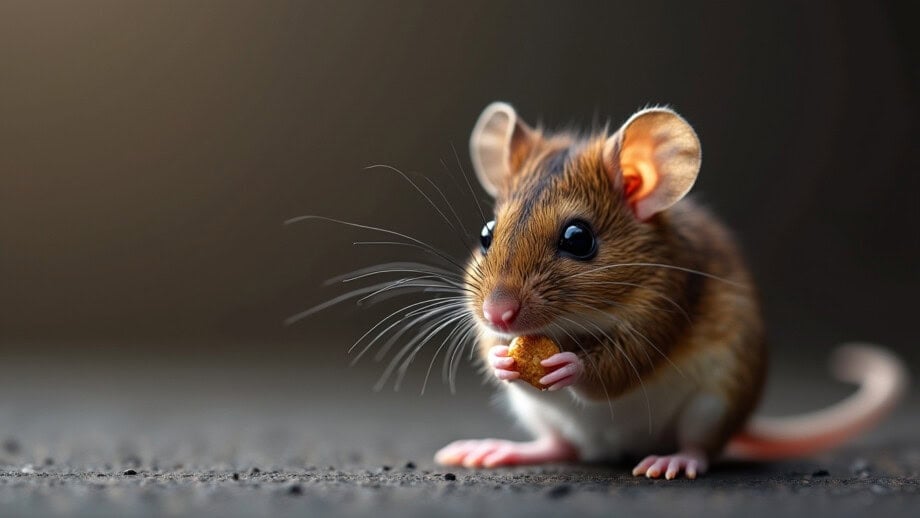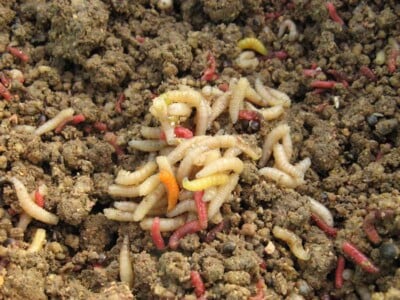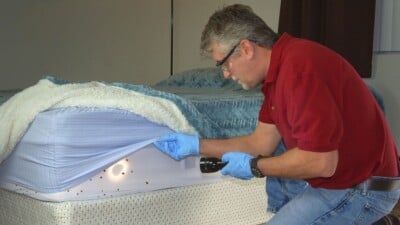How to Get Rid of Mice In Your Home – Step by Step
Rodents can carry a wide variety of diseases transmissible to humans. Learn how to get rid of mice FAST using proven, organic and natural control strategies.

Rodents can carry a wide variety of diseases transmissible to humans. If you suspect you have mice in your home, don’t worry, there are many ways you can not only prevent but get rid of mice in your home.
House mice (Mus musculus) are the most common rodents in people’s homes. In fact, they have lived with humans so long they have trouble surviving without us. Originally from Asia, house mice have traveled with humans all over the world.
House mice cause more money in damages to food and buildings than any other rodent.
In this article, learn how to get rid of mice along with the methods you can use to keep them away to begin with.
What Do Mice Look Like?
House mice are small and only weigh 1/2 ounce. They are 5-7 inches, including 3-4 inches of tail. Their brown to gray fur acts as camouflage. The ears are large for the size of the mouse and the eyes are black.
Deer mice (Peromyscus maniculatus) occasionally enter homes. They are gray on top and white on the bottom. They also have a much longer, mostly hairless tail.
Mice can jump up to 12 inches from a flat surface and can run up rough vertical surfaces, such as wood. They can follow a cable or wire into the house by running on top of it acrobat style. Mice are good climbers, too. They can squeeze through a hole as small as 1/4 inch in diameter.
Mice have amazingly sensitive hearing, smell, touch, and taste. They do not have great eyesight but the keenness of their other senses makes up for that.


Lifecycle of a House Mouse
Mice become sexually mature at 6-10 weeks. Females have from 5-10 litters, each of 5-6 pups, in one year. Each of the female pups repeats having this many litters.
Even though the house mouse only lives 9-12 months, one fertile female can cause a whole mouse infestation in no time.
According to the Building Performance Institute, a single female mouse can have up to eight litter per year, resulting in as many as 100 baby mice!
Dangers of Mice
Mice are very dangerous. They eat and foul a great deal of grain and other food each year. They prefer cereal grains but will eat many other things if available.
Direct Diseases Mice Carry
Mice leave urine and feces everywhere they go and also on the food they eat. They leave crumbs everywhere with traces of them. Their bodily by-products, along with the hair mice shed, carry a number of serious illnesses.
According to the Center for Disease Control and Prevention (CDC), these include leptospirosis, lymphocytic choriomeningitis (LCM), tularemia, and salmonellosis. The most common disease mice carry is salmonellosis or food poisoning.
Indirect Disease Transmission
It isn’t just the mice that are a problem. A number of diseases are spread by the fleas and ticks that live on the mouse. These parasites can bite people, pets, and livestock and spread diseases to them.
We have all heard of the bubonic plague that rat fleas spread. Mice don’t spread that, but a mite on them causes Rickettsioses.
This is similar to Rocky Mountain Spotted Fever and can range from mild to life-threatening.
Property Destruction
Mice must gnaw continually to keep their incisors from growing too much. They can gnaw through a number of things, including wood, drywall, insulation, plastic, rubber, vinyl, and insulating foam.
Mice also gnaw on electrical wires and can cause a fire by short-circuiting one. Mice shred paper or fabric to use to make a nest in a quiet, hidden place.
They also nest in insulation in the walls or in the attic.
How Do I Know If I Have a Mice Infestation?
Mice are nocturnal. People often see evidence of them long before they see an actual mouse. These signs include:
- The first step is to learn how to spot mouse droppings as this can be the first indicator that you may have a mouse infestation. Mouse droppings look like rod-shaped dark feces that are narrow at the ends. A mouse leaves 50-75 pellets in the area a day.
- Damaged food packages in the pantry are a sign you may have mice.
- Pathways frequented by mice get oily stains on them.
- Noticing crumbs or debris from food on the floor, in the pantry, or in strange places like the shelves.
- Mice, particularly when there are lots of them, exude a musty odor.
- Fresh gnaw marks that are 1/32 inch wide were probably made by a mouse.
- Noise in the walls and attic can be a sign of mice. People are often surprised how such a little creature can make so much noise.
How to Prevent Mice from Entering Your Home
Effective mouse control starts with preventing any more mice from entering the building or home. Rodent proofing includes exclusion and sanitation. Repellents may also be used.
Seal Entry Points
The best way to prevent mice is to exclude them. Since a mouse can get in through a 1/4 inch hole this can be difficult.
Mice will try to get inside when the temperature drops. Use caulk or weatherstripping to seal small holes in your home’s foundation, siding, and entrances.
Mice won’t chew steel, so you can put a piece of steel wool into each hole and caulk it to keep it in place. You can use copper wool or small patches of metal hardware cloth instead.
- Seal all the cracks and holes in the foundation and walls.
- Wedge the steel fibers in a crack with a flat screwdriver. Use mortar or caulk to make sure it stays there.
- Seal the openings where pipes, electrical wires, and cables come into the house.
- Since mice can climb, you need to trim tree branches that are over your roof or get close enough to the wall for the mouse to jump to it.
- Seal the attic.
Restrict Their Food Supply
While good sanitation will not prevent mice, bad sanitation will attract them. There are several things you can do to make mice feel unwelcome. They need food and shelter just like we do.
Unfortunately, mice only require a tiny bit of food each day. Remove the foods they prefer to eat to get rid of them in your home.
All grains, pet food, and other dry commodities should be stored in glass or metal containers, which keep food safe because mice cannot chew through them.
Keeping that in mind, here are some tips you’ll find helpful.
- Store food such as grains, pet food, and dry other goods in metal or glass containers since mice can’t chew through them.
- Put trash in a metal can with a tight-fitting lid.
- If you have fruit trees, pick up the fallen fruit so the mouse isn’t attracted to it.
- Pick up pet food at night so the mice do not have access to it.
- Wipe up food spills promptly.
Get Rid of Areas They Can Seek Shelter
Mice need shelter just as we do, and certain things in your home may make it a more hospitable place for them to settle in.
Here’s what you can do to get rid of nesting materials and clean up areas where they might seek shelter:
- Remove debris in your yard.
- Keep the yard mowed.
- Stack lumber and firewood on racks at least 8 inches off the ground and 8 inches from any wall.
- Store fabric in mouse-resistant containers.
- Vacuum regularly, including areas such as the backs of closets and pantries.
Use Essential Oils
Mice can’t stand the smell of certain essential oils with a strong smell such as peppermint and clove oil. Soak cotton balls in your preferred essential oil and place them in areas where you’ve noticed mouse activity, such as drawers, shelves, and under sinks.
Even though the smell alone won’t get rid of mice, it can work well with other methods to keep them away.
Use Ammonia
Speaking of strong smells, essential oils aren’t the other thing that repels mice. They particularly dislike the strong smell of ammonia as it smells like a predator’s urine.
You can try this method similar to essential oils by placing cotton balls soaked in ammonia in places where mice like to hang out.
Try Other Repellents
Apart from essential oils and ammonia, there are several other types of repellents you can use
Ultrasonic devices work by emitting a high, irritating sound that only rodents can hear. The sound changes periodically so the mice will not get used to it. These devices will not bother dogs and cats. Each unit covers approximately 400 square feet. Plug one in each room for best results.
Mint repellent place packs use spearmint and peppermint to repel mice. Place packs are used so you can place them behind appliances, along walls where mice run, and in garages and basements without having to touch the actual repellant.
Rodent organic granules can be shaken out where ever rodents are a problem. Use these to get to difficult-to-reach places. The smell repels mice and other rodents.
How to Get Rid of Mice
It’s getting worth the while to prevent mice from ever entering your home in the first place. But after that, you need you find a way to get rid of any mice infestation that you currently have in your home.
There are a few main ways to remove mice from your house in a safe way:
Mouse Traps
Snap traps baited with peanut butter or cheese are the traditional way to get rid of mice.
This quick-trigger system catches mice in their tracks and is by far the most common type of mouse trap.
They are a human way to kill mice. There are even one-use traps that you throw out without ever seeing the dead mouse.
However, if you do not want to kill the mice in your home, you can consider using a live trap.
Mice are suspicious of new things, so they will take a few days to enter the trap. Place the traps where you see signs of them. Use multiple traps for better coverage.
Since mice are nocturnal, check your traps each morning. Take note of the traps that catch the most mice so you can place more in that location.
Once the mice are humanely live-trapped, take them to a wooded area or big field and open the trap. The mouse has to chew through a cracker to get out so you never have to handle her. Once she is gone, you can collect the trap and re-use it.
But in case you ever feel the need to pick up a dead mouse, always wear thick gloves and keep your hands away when handling it.
Baits
Rodent baits work well, but traditional rodent baits are very dangerous. Call a professional pest control company without a doubt if the mouse problem is so bad that you feel that chemical control is required.
There are a number of risks that come with the use of rodenticides that contain poison designed for rodents.
They kill not only rodents but the animals that feed on the mice that have eaten the bait. Dead mice can get trapped in the walls and attic and die, causing a bad smell.
Use Organic Bait
Agrid3 Bait is the only organic rodent bait. It has cholecalciferol, or Vitamin D3, in it which draws the calcium out of the mouse’s bones and into his bloodstream. This kills the mouse.
While this bait will not harm a pet that eats a poisoned mouse, the pellets will. It is a good idea to use a bait station. This keeps the pellets away from children, pets, and livestock.
For best results, put out fresh bait daily. Mouse control should be continued for 15 days after you no longer see signs of mice.
Mice carry diseases and damage buildings and belongings. Whether you want to prevent them from coming into your house or get rid of them, there are safe and organic ways of doing so.













